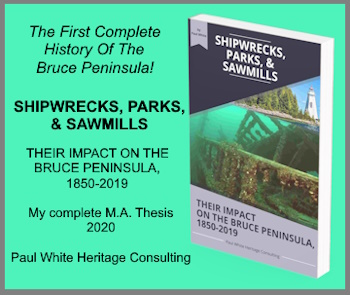Shipbuilding History of Owen Sound
The shipbuilding history of Owen Sound began in the 1840s and continued for more than a century. This industry has provided many colourful moments in Owen Sound's growth from a pioneer outpost to a vibrant Georgian Bay port city.
Owen Sound’s harbour has always been a hive of activity. In the beginning the harbour was this community’s connection with the outside world as the only viable transportation link was by water. At first, the community was dependent upon the Fly, a schooner owned by a local entrepreneur, W. C. Boyd to bring supplies and take produce to market. Other coastal traders also called at Sydenham. But their visits seem to have been sporadic depending upon weather conditions and the whims of their captains. However, as the southern Georgian Bay region became more populated, shipping traffic increased to meet the needs of an expanding market place. To meet this need ship building became an important industry in the area.
Shipbuilding Industry Comes to Owen Sound
In 1846 a small shipbuilding enterprise began in the community. To facilitate the new enterprise a carpenter named Henry Wood established a woodworking shop near the harbour. The first vessel built was the Anne Mackenzie. This ship had a 100 foot keel with a twenty-four foot beam. The date of her launch is the subject of some debate. James Barry writes in his book, Georgian Bay, The Sixth Great Lake that she was launched in 1848. However in his History of Grey County, Davidson states that the Mackenzie first sail in 1846.
The Mystery Surrounding the Anne Mackenzie
The date of her launch is not the only mystery which surrounds the Ann Mackenzie. Her owner did not pay one of the carpenters, perhaps Henry Wood, for work on her construction. Before the debt that could be collected the Mackenzie left her home port. The disgruntled carpenter, hired a lawyer to trace the ship and recoup his losses.
It was known that the ship had gone to Toronto. But before action could be taken the Ann Mackenzie left for Quebec carrying a load of lumber. The agents working for the carpenter set out for Quebec but before they arrived she eluded them and sailed for Britain. Attempts to locate the vessel in Britain were equally ineffective. It seems the Ann Mackenzie never returned to Canada. It was, however, later located in Rio De Janeiro far from the jurisdiction of the Upper Canadian authorities.
The controversy surrounding the construction of the Ann Mackenzie did not stop the construction of ships in Owen Sound. Soon after the Mackenzie was completed the Elizabeth Broder was launched into service as a coastal trader on Georgian Bay.
A third vessel, a two-masted schooner the Belle McPhee, was launched at Brooke about 1850. She plied the Great Lakes for nearly three years before being brought to Owen Sound for renovations. A third mast was erected and thirty feet was added to her length. This was probably achieved by cutting her in half and a new section, including another mast, added at that point.
Unfortunately, the Belle McPhee’s sailing days were numbered. About a year after she was launched a second time she hit a rock off Thornbury and sank. Fortunately, her crew were saved by a fishing tug.
Some might argue that this community’s initial shipbuilding projects were far from successful considering the controversy surrounding the Ann Mackenzie and the sinking of the Belle McPhee. However, the construction of these vessels marked the beginning of long connection between Owen Sound and the shipbuilding industry. Throughout rest of the 19th century many more vessels were built there. Perhaps the most notable being the ships built at the Polson yards near the end of the century.
In the twentieth century Russell Bros. continued the tradition of shipbuilding in Owen Sound and Kennedy’s contributed to that industry as major suppliers of propellers for vessels around the world.
Georgian Bay Shipping
List of Lighthouses on the Great Lakes: If you have names and/or pictures of Great Lakes Lighthouses please submit them along with details of their location.
Georgian Bay Ships: A List of all the ships that sailed on Georgian Bay until the 1960s. This list is not complete. If you know of a ship that sailed the waters of Georgian Bay please contact me with information about that vessel, and, if you have a picture that I could post with it, that would be much appreciated.
1885: A Memorable Summer Job for Owen Sound teenage boys on the Great Lakes would have historic importance, not mention a possible exciting career opportunity.
Hindman Transportation Company was a well-known Great Lakes shipping company for many years. Here you will find pictures of many of the Hindman ships
Owen Sound Harbour – A Photographic History, by Robert A. Cotton is a book that interests my historiographical curiosity.
Commercial Great Lakes Fishing It is probably safe to suggest that the commercial fishing industry was an important part of the early growth of this region.
A Georgian Bay fishing vacation has long been a popular attraction in the Bruce Peninsula region. During fishing derbies, the regional waterways are dotted with fishing boats of all shapes and sizes.
The Georgian Bay Mackinaw, designed by William Watts of Collingwood is an example of a Georgian Bay innovator creating a vessel to service the needs local mariners.
Great Lakes fishing is an asset that is protected and developed, not only for its economic potential but also for those who just enjoy spending a day by the side of a river or in small fishing boats trying to catch “the big one”!
Great Lakes Fishing History is not without its controversy. The impact of the fishing industry was such that it played an important role in the development of communities along the Georgian Bay and Lake Huron shoreline.
Georgian Bay Travel Before the Winter Freeze-Up could be a dangerous time for mariners in the early years in this region.
A Harbinger of Spring on the Great Lakes in pioneer times, was the eagerly awaited news that a lighthouse had been lit and shipping traffic could begin sailing from port to port.
Lumber Hookers Lumber hookers and tugs were an important innovation to improve the transportation of lumber on Georgian Bay.
Mapmakers on Georgian Bay were also explorers. They mapped the Georgina Bay shoreline noting safe harbours, dangerous reefs and other guides for sailors and pioneer settlers looking for a place to call home.
Paddling Georgian Bay & Pondering: traversing parts of this great waterway in a canoe leads one to wonder about the ships of a bygone era battling the rough seas they encountered.
Parry Sound Shipping History: The Parry Sound area has always been connected to the southern regions of the Province of Ontario by a system of good roads. Or has it?
Parry Sound’s shipping history 2 is more than the tragic sinking of the Waubuno or the later catastrophe surrounding the sinking of the Asia.
Sailing Season Closing: A Frantic Time on Peninsula as ships raced from port to port delivering and picking up passengers and produce before the waterways froze.
Ship Captain Andrew Port was not only a dynamic and brave Georgian Bay mariner, he was a personal favourite historical character of mine.
Ships Stuck in Ice: The Oak Glen was icebound in 1996 but this sailing hazard has been impacting vessels on Georgian Bay since the beginning of time.
Lake Huron shipwrecks, the Hibou often occurred in the Georgian Bay region of that Great Lake due to the often violent waters that could strike unsuspecting vessels like the Hibou.
Shipwrecks: The "Asia" wrecked off the eastern coast of Georgian Bay taking all but two of the more than 100 passengers to a watery grave.
Masters, Mates, and Pilots Association created its first Canadian chapter on Georgian Bay, providing maritime safety education, and other seafaring issues to better inform its membership.
Pioneer Travel Aboard the Fly Tells the story of a sailing vessel as the tenuous link between survival and death in a pioneer settlement in the 1840's in Upper Canada.
Sailing Stories: the Captain Who Smelled his way into Port The Captain Who Smelled his Way into Port details how pioneer seamen on Georgian Bay safely sailed the rough waters without the aid of the modern technological tools so readily used by today's mariners.
Sailing Story: The Voyage of the Prince Alfred the incredible voyage of the Prince Alfred, fraught with danger for both vessel and the crew in the winter of 1880.
Shipbuilding As the southern Georgian Bay region became more populated shipping traffic increased to meet the needs of an expanding market place.
The Summer of 1844 was No Picnic for the early settlers in the pioneer area near what would become Owen Sound on Georgian Bay.
The CPR Grain Elevator Fire of 1911 spelled the end of Owen Sound's role as the eastern terminus of the CPR Great Lakes Fleet.
Georgian Bay shipping occurred long before the first Europeans paddled these waters. But the fur and timber trades opened Georgian Bay to shipping in a big way!





